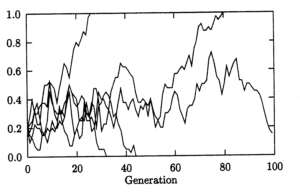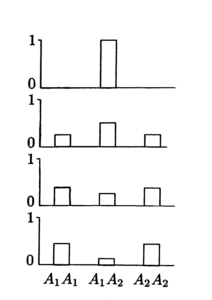


Iconic images of random genetic drift: The elimination of alleles by chance; the “U” shaped distribution of allele frequencies in an ensemble of populations; and Sewall Wright’s representation of populations occupying space on an adaptive landscape under control of multiple evolutionary processes including drift.
In 2006 I defended my PhD dissertation [VIEW PDF] in the Philosophy Department at Johns Hopkins, advised by Peter Achinstein (in its initial stages, by Karen Neander). The theme is chance in explanation in evolutionary biology, the dissertation’s title Random Drift: Chance and Explanation in Evolutionary Biology intended to mirror the title of William Dray’s book Laws and Explanation in History. My argument mirrors Dray’s as well: Dray argues that in history, there are unexpected events that can nonetheless be explained, and I argue that in evolution, the same holds true. Things that happen by chance can be explained, because even if we cannot explain why they happened, we can explain how. Finding out the process by which they occurred tells us something important. Random genetic drift is one such chance process that’s central to evolutionary explanations. This is in contrast to some who claim that only what occurs in evolution by natural selection can be explained. I develop a theory of explaining processes, and identifty four central phenomena in evolutionary biology in which such explanations are used: The elimination of a favorable allele by chance; Wright’s shifting balance process; the origin of species in allopatry; and the shape of phylogeny and the punctuated equilibria.
Abstract
The central claim for which I argue in this dissertation is that there are important phenomena that occur by random drift that evolutionary biologists explain using a strategy I term “process explanation.” This claim puts me at odds with an influential view about the nature of explanation that I term “Hempelianism.” Hempelianism is the view that the scientific explanation of a particular event E requires (a) showing that E was to be expected, or indicating the degree to which it would have been rational to expect E’s occurrence; and (b) laws of nature. My central claim entails that both (a) and (b) are false. A process explanation consists of a narrative describing events causally relevant to the event to be explained. These narratives need not contain laws, show that the event to explained ought to have been expected, or indicate the degree to which it would have been rational to expect the event. My position about random drift also puts me at odds with evolutionists who, influenced by Hempelianism, claim that only natural selection can explain evolution. In my argument, I articulate the strategy of process explanation and defend it against Hempelian critics; describe a mechanism of random drift known as “indiscriminate isampling;” and describe process explanations of phenomena of drift that occur by indiscriminate sampling.